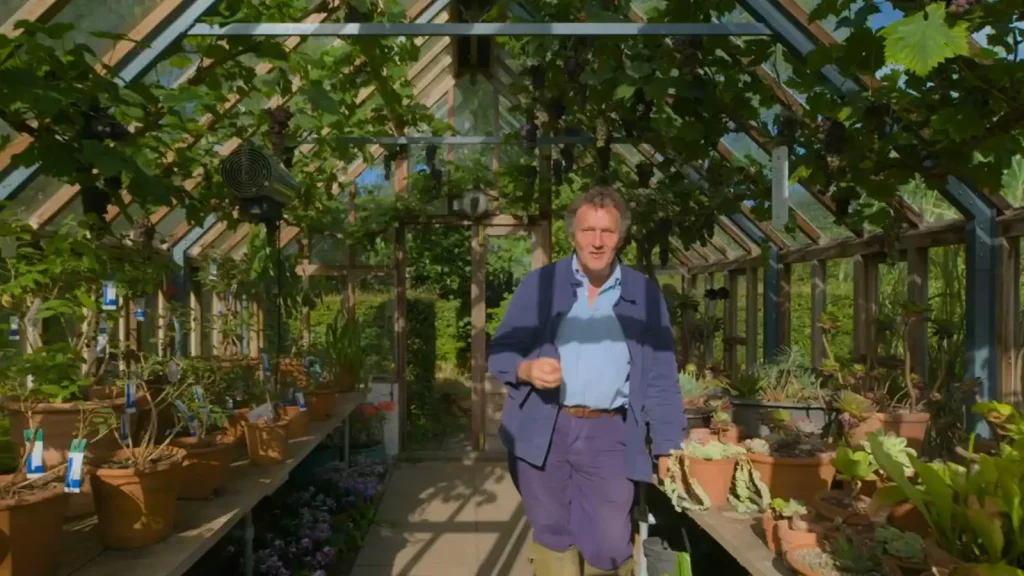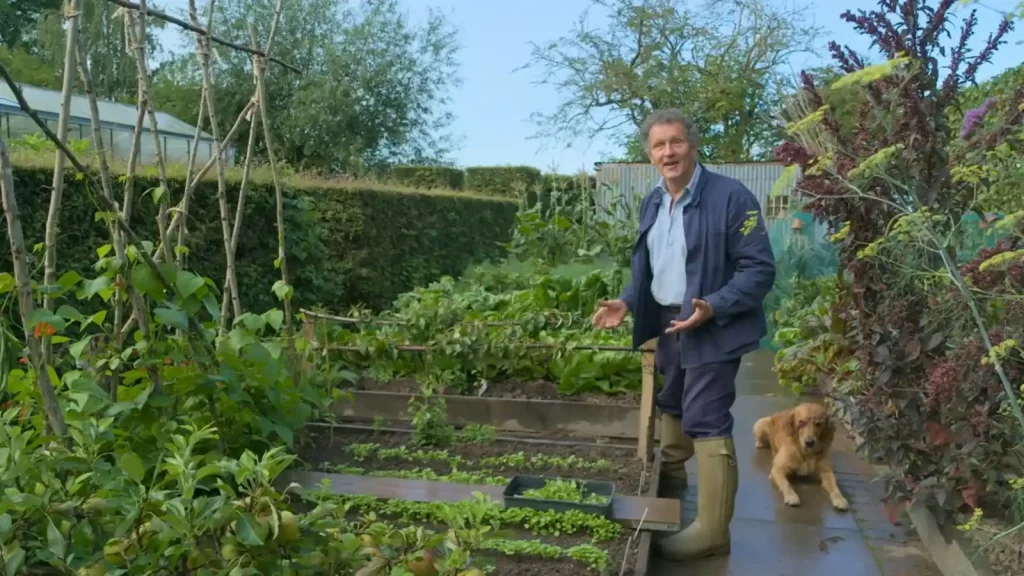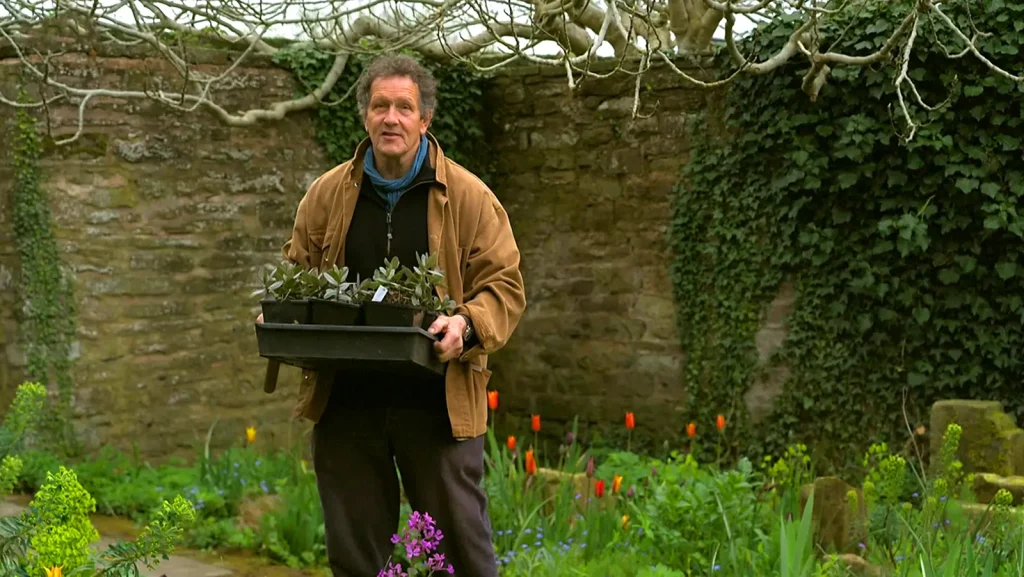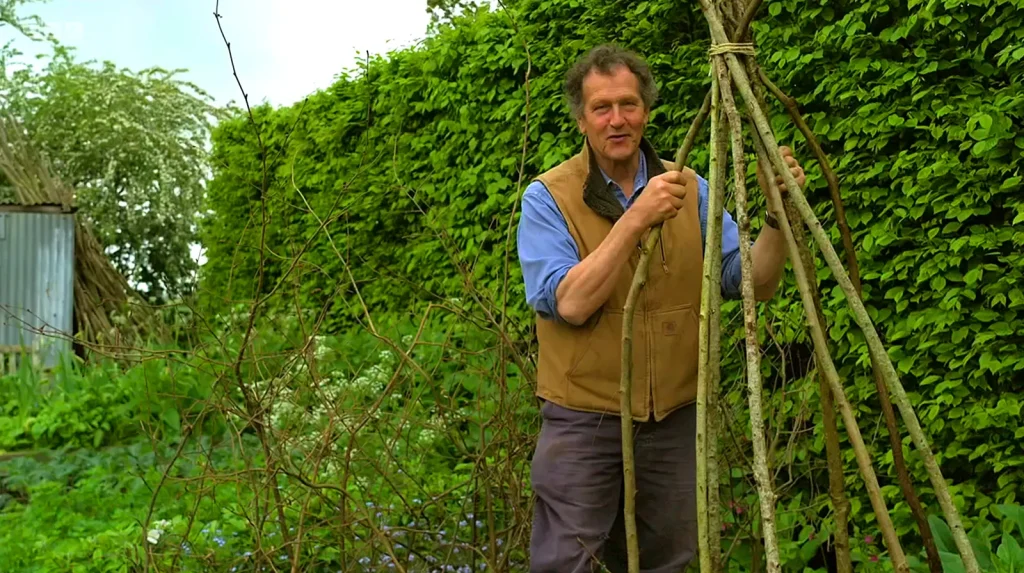In Gardeners World 2024 Episode 23, Monty Don is fully immersed in his autumn tasks, setting the stage for a vibrant spring. He begins by planting daffodils, ensuring that these cheerful blooms will grace the garden with their golden hues next year. As the leaves fall and the temperature drops, Monty turns his attention to the essential job of pruning his summer-fruiting raspberries, which have provided an abundant harvest this past season. By carefully cutting back the canes, he not only encourages new growth but also sets the plants up for an even better yield next summer.
On the Mound, Monty introduces a fragrant honeysuckle, a plant that promises to bring both scent and beauty to the garden. As always, Monty shares his wisdom, offering valuable advice on managing one of the most persistent challenges for gardeners—bindweed. His tips and tricks for keeping this invasive plant at bay will resonate with anyone who has battled it in their own garden.
The episode also takes us on a journey to Devon, where Frances Tophill meets with the innovative horticulturist, Josh Sparkes. Josh’s experimental plot is a living laboratory, where he is pioneering new methods of sustainable food production. Frances explores the intricacies of his work, uncovering some of the key techniques he employs to grow food in harmony with nature. Josh’s approach not only challenges conventional practices but also offers a glimpse into the future of gardening, where sustainability is at the forefront of everything we do.
Back at home, Nick Bailey reveals a stunning transformation in his garden—a new border that has already become a highlight, despite being planted just a few months ago. Nick takes us through the design process, explaining how he carefully selected plants that would complement each other while providing year-round interest. His passion for gardening shines through as he shares insights into the choices he made, from the color palette to the plant varieties, ensuring that the border will continue to evolve and delight for years to come.
In Birmingham, we visit a head gardener who oversees a traditional arts and crafts garden, a space that embodies the beauty and craftsmanship of a bygone era. This garden is meticulously maintained, and the head gardener shares some of the secrets that keep it looking spectacular throughout the seasons. From the careful selection of plants to the techniques used in pruning and training, these tips offer inspiration for anyone looking to create a garden that is both timeless and enchanting.
Gardeners World 2024 Episode 23
Finally, we meet an enthusiastic amateur gardener in London who has found a way to cultivate a thriving vegetable garden in the most unlikely of places—pots. Despite the limited space, this gardener has managed to grow a wide variety of vegetables, proving that you don’t need a large garden to enjoy homegrown produce. Their creative use of containers and clever planting strategies provide practical solutions for urban gardeners everywhere, demonstrating that with a little ingenuity, it’s possible to grow your own food no matter where you live.
This episode of Gardeners’ World 2024 is packed with inspiration and practical advice, offering something for every type of gardener, whether you’re tending a sprawling estate or a small urban plot. Monty Don’s hands-on approach, combined with the insights from other gardening experts, ensures that viewers come away with new ideas and the confidence to try something new in their own gardens.
The Art of Thinning Turnips: Maximizing Your Harvest
The Importance of Proper Turnip Spacing
Picture a lush garden, bursting with vibrant greens and promising the sweet reward of a bountiful harvest. Now, zoom in on a patch of turnips, their leaves reaching for the sky. But wait! Something’s amiss. The plants are huddled together like commuters on a packed subway train, each vying for its own spot of sunlight and nutrients.
This, dear gardeners, is where the art of thinning comes into play. Thinning turnips isn’t just a mundane task; it’s a crucial step in nurturing a thriving vegetable patch. Without proper spacing, your turnips will struggle like siblings fighting over the last cookie. They’ll compete fiercely for water, nutrients, and light, resulting in stunted growth and disappointing yields.
The Step-by-Step Thinning Process
So, how do we transform this crowded turnip party into an orderly gathering? Let’s dive into the nitty-gritty of thinning turnips. First things first, timing is key. Begin your thinning adventure when the seedlings are about two weeks old and sporting a couple of true leaves.
Start by surveying your rows of turnips. Your goal? To create space between plants, allowing each turnip to spread its leafy wings. Here’s a step-by-step guide to mastering the art of thinning:
- Assess the density: Look for areas where seedlings are clustered too closely.
- Choose your victims: Identify the weakest or smallest seedlings for removal.
- Get your hands dirty: Gently pull out the selected seedlings, being careful not to disturb their neighbors.
- Spacing is crucial: Aim for about 2-3 inches between each plant initially.
Remember, thinning isn’t a one-and-done deal. As your turnips grow, you’ll need to thin them again, eventually leaving 4-6 inches between plants. Think of it as a gradual process, like slowly decluttering your home. With each round of thinning, you’re giving your turnips more room to flourish.
Benefits of Well-Thinned Turnips
Now, you might be wondering, “Is all this thinning really worth the effort?” The answer is a resounding yes! Properly spaced turnips are like well-behaved children at a dinner party – they thrive when given room to grow and shine.
First off, thinning improves air circulation. When plants aren’t crammed together, air can flow freely between them, reducing the risk of fungal diseases. It’s like opening the windows in a stuffy room – suddenly, everything feels fresher and healthier.
Secondly, thinned turnips get more light exposure. Each leaf can bask in the sun’s rays, soaking up energy to fuel robust growth. Imagine your turnips as solar panels – the more sunlight they can absorb, the more energy they can produce.
But the benefits don’t stop there. Proper spacing also means less competition for nutrients and water. Your turnips won’t have to elbow each other out of the way to get their fair share of resources. The result? Bigger, juicier turnips that’ll make your taste buds dance with joy.
Implementing Turnip Thinning in Your Garden
Ready to roll up your sleeves and give your turnips some breathing room? Here are some practical tips to help you become a thinning maestro:
- Time it right: Choose a cloudy day or early morning to thin your turnips. This reduces stress on the remaining plants.
- Water first: Moisten the soil before thinning. This makes it easier to pull out seedlings without disturbing their neighbors.
- Be selective: Remove the weakest seedlings, leaving the strongest to grow.
- Use tools wisely: For precise thinning, consider using small scissors to snip off unwanted seedlings at soil level.
- Don’t waste: Those thinned seedlings? They’re not trash – they’re treasure! Toss them into salads for a peppery punch.
Remember, thinning isn’t just about following rules; it’s about developing a keen eye and a gentle touch. As you practice, you’ll start to intuitively understand the needs of your plants. Soon, you’ll be thinning turnips like a pro, creating a garden that’s not just productive, but also a joy to behold.
So, next time you’re out in your garden, take a moment to assess your turnip patch. Are they crowded? Could they use some space? If so, it’s time to embrace the art of thinning. Your turnips will thank you with a harvest that’s truly worth writing home about!
Innovative Gardening: Martha Swales’ Urban Oasis
Transforming a City Space into a Flourishing Garden
Imagine stepping off a bustling city street, the cacophony of traffic and urban life fading away as you enter a verdant sanctuary. This isn’t a dream or a scene from a movie; it’s the reality Martha Swales has created in the heart of south-east London. Her garden stands as a testament to the power of imagination and determination, proving that even in the most unlikely places, nature can thrive.
Martha’s urban oasis is a stark contrast to its surroundings. While trains rumble by and planes soar overhead, her 5×8 meter plot bursts with life, color, and the promise of a bountiful harvest. It’s a magical haven that showcases the potential hidden within every patch of urban soil, no matter how small or seemingly inhospitable.
Creative Techniques for Small-Space Gardening
So, how does Martha make the most of her compact city garden? The secret lies in her innovative approach to space management. Despite its modest size, Martha’s garden is a masterclass in organization and creativity. She’s divided her plot into distinct zones, each serving a specific purpose while contributing to the overall harmony of the space.
One of Martha’s clever strategies is the creation of a perennial bed that doubles as a fruit orchard. This area, brimming with wild strawberries and fruit trees, provides structure to the garden while maximizing productivity. Meanwhile, dedicated vegetable beds offer flexibility, changing with the seasons to ensure a constant supply of fresh produce. This thoughtful layout allows Martha to grow a diverse range of plants without the garden feeling cluttered or chaotic.
Inspiring Ideas for Urban Gardeners
Martha’s garden is more than just a pretty space; it’s a treasure trove of innovative gardening ideas that can spark the imagination of any urban dweller. One of her most inspiring techniques is her approach to plant propagation. Instead of relying solely on nursery-bought plants, Martha breathes new life into supermarket herbs, transforming them into thriving garden specimens.
Take mint, for example. Martha’s lush mint patch didn’t start life in a garden center pot. Instead, it began as a humble supermarket packet of cut herbs. With a little know-how and patience, Martha turned these kitchen staples into a flourishing perennial plant. This method not only saves money but also adds an extra layer of satisfaction to the gardening process. After all, there’s something magical about watching a plant that was destined for a one-time use in the kitchen transform into a permanent garden resident.
Implementing Urban Gardening Techniques
Feeling inspired by Martha’s urban oasis? Here are some practical steps you can take to start your own city garden adventure:
- Assess your space: Even a windowsill or balcony can become a mini garden.
- Plan your zones: Divide your area into sections based on purpose and plant needs.
- Think vertically: Use walls, trellises, and hanging baskets to maximize growing space.
- Experiment with propagation: Try growing plants from supermarket herbs or vegetable scraps.
- Embrace diversity: Mix ornamentals with edibles for a beautiful and productive garden.
Remember, urban gardening is as much about creativity as it is about horticulture. Don’t be afraid to think outside the box and try new things. Start small, perhaps with a herb garden on your kitchen windowsill, and gradually expand as your confidence grows. Before you know it, you might find yourself, like Martha, creating a thriving oasis in the heart of the city.
Urban gardening isn’t just about growing plants; it’s about growing a connection to nature, to our food, and to our communities. So why not take that first step today? Your own urban oasis is waiting to bloom!
Josh Sparkes’ Agroecological Revolution: Sustainable Food Production
A New Approach to Growing Food
In the heart of Devon, amidst rolling hills and verdant landscapes, lies a 15-acre plot that’s quietly revolutionizing the way we think about food production. This isn’t your typical farm or garden; it’s a living laboratory where ancient wisdom meets modern innovation. At the helm of this green revolution is Josh Sparkes, a horticultural maverick whose approach to farming is as refreshing as a summer rain.
Imagine a place where vegetables grow in harmony with trees, where weeds are welcomed rather than banished, and where the line between wild and cultivated blurs into a beautiful tapestry of biodiversity. This is Josh’s world, a fusion of Japanese natural farming techniques and agroforestry principles that’s turning conventional agriculture on its head. It’s a system that doesn’t just grow food; it nurtures entire ecosystems.
Key Principles of Agroecological Farming
At the heart of Josh’s approach lies the concept of polyculture. Unlike traditional monoculture farming, where vast fields are dedicated to a single crop, polyculture embraces diversity. Picture a garden where tomatoes, beans, and squash grow side by side, their roots intertwining beneath the soil, each plant supporting and benefiting from its neighbors. This isn’t chaos; it’s a carefully orchestrated symphony of growth.
But Josh’s innovation doesn’t stop at ground level. He’s also a champion of vertical growing, making the most of limited space by encouraging plants to reach for the sky. Sunflowers stand tall, providing support for climbing beans, while fruit trees offer shade and structure to lower-growing plants. This three-dimensional approach to gardening not only maximizes yield but also creates a more resilient ecosystem, mimicking the layers found in natural forests.
The Beauty and Productivity of Natural Gardening
Step into Josh’s garden, and you’ll be struck by its wild beauty. This isn’t the manicured perfection of a traditional English garden, but rather a vibrant, living tapestry that changes with the seasons. Flowers mingle freely with vegetables, attracting pollinators and beneficial insects. The air hums with life, from bees busily working the blossoms to birds flitting among the fruit trees.
But don’t let the apparent wildness fool you. This garden is incredibly productive. Tucked among the seeming chaos, you’ll find an abundance of fruits, vegetables, and herbs. Aubergines with glossy purple skins nestle beside fragrant herbs, while apple trees heavy with fruit provide a canopy for shade-loving plants below. It’s a testament to the power of working with nature rather than against it, proving that sustainability and productivity can go hand in hand.
Adopting Agroecological Practices at Home
Inspired to bring a touch of Josh’s agroecological magic to your own garden? Here are some practical steps to get you started:
- Embrace polyculture: Start by mixing different plant families in your beds. Try the classic “Three Sisters” combination of corn, beans, and squash.
- Think vertically: Use trellises, poles, or even sturdy plants like sunflowers to support climbing varieties. This maximizes space and mimics natural growth patterns.
- Welcome beneficial weeds: Not all weeds are the enemy. Some, like dandelions, can help improve soil structure and attract pollinators.
- Experiment with bokashi composting: This Japanese method of fermentation composting is perfect for small spaces and can help you recycle kitchen waste efficiently.
- Create microclimates: Use taller plants or structures to create sheltered areas for more delicate species, just as you’d find in a natural forest ecosystem.
Remember, transitioning to agroecological methods is a journey, not a destination. Start small, perhaps with a single polyculture bed or by incorporating vertical elements into your existing garden. Observe, learn, and adjust as you go. You may be surprised at how quickly your garden transforms into a thriving, productive ecosystem.
By adopting even a few of these principles, you’re not just growing food; you’re nurturing biodiversity, improving soil health, and contributing to a more sustainable future. So why not take a leaf out of Josh’s book and start your own agroecological adventure today? Your garden, and the planet, will thank you for it.
Conclusion Gardeners World 2024 Episode 23: Embracing Innovative Gardening Techniques

Recap of Key Gardening Insights
As we’ve journeyed through the world of innovative gardening, we’ve uncovered a treasure trove of insights that can transform any patch of earth into a thriving oasis. From the meticulous art of thinning turnips to the wild beauty of agroecological farming, each technique we’ve explored offers a unique perspective on cultivating both food and beauty.
Remember how we learned that giving turnips room to breathe can lead to a more bountiful harvest? This simple act of spacing plants properly is like conducting an orchestra – each vegetable needs its own spot to play its part in the symphony of your garden. Similarly, the urban gardening techniques we discovered prove that even the smallest balcony can become a productive green space, much like a miniature Eden in the concrete jungle.
Encouragement for Experimentation
Now, dear gardeners, it’s time to roll up your sleeves and get your hands dirty! The world of gardening is ripe for experimentation, and your outdoor space – be it a vast acreage or a humble windowsill – is your laboratory. Why not start by trying out polyculture in a corner of your garden? Plant some companions like tomatoes, basil, and marigolds together and watch how they support each other’s growth.
Or perhaps you’re feeling inspired to create your own urban oasis? Start small by propagating herbs from supermarket cuttings. Imagine the satisfaction of seeing a sprig of store-bought mint transform into a lush, fragrant plant under your care. Remember, every master gardener started as a novice, so don’t be afraid to make mistakes. Each wilted plant or failed crop is just a stepping stone to greater gardening wisdom.
The Future of Sustainable Gardening
As we look to the horizon, it’s clear that these innovative gardening techniques are more than just trends – they’re shaping the future of how we grow food and interact with nature. The principles of agroecology, for instance, offer a blueprint for creating gardens that not only feed us but also nurture the entire ecosystem. By embracing these methods, we’re not just growing plants; we’re cultivating a more sustainable world.
Imagine a future where city rooftops are transformed into productive gardens, where suburbs are dotted with food forests, and where even the smallest balcony contributes to urban biodiversity. This isn’t a far-fetched dream – it’s a vision that’s already taking root in communities around the globe. By adopting these innovative techniques, you’re not just improving your own garden; you’re becoming part of a global movement towards more sustainable, resilient food systems.
So, as you tend to your plants, remember that you’re nurturing more than just flowers or vegetables. You’re cultivating hope for a greener future, one seed at a time. Whether you’re thinning turnips, propagating herbs, or experimenting with polyculture, each action you take in your garden ripples out into the world. So go forth, experiment, and let your garden be a testament to the power of innovation and the enduring beauty of nature working in harmony with human ingenuity.
F.A.Q. Gardeners World 2024 Episode 23
Q.: What are the main tasks Monty Don performs in Gardeners’ World 2024 Episode 23?
A.: In Gardeners’ World 2024 Episode 23, Monty Don focuses on essential autumn gardening tasks to prepare for a vibrant spring. These include planting daffodils to ensure beautiful blooms next year and pruning summer-fruiting raspberries to promote healthy growth and a better yield next season. Monty also introduces a fragrant honeysuckle to the garden and shares valuable advice on managing bindweed, an invasive plant that many gardeners struggle with.
Q.: How does Monty Don address the issue of bindweed in this episode?
A.: Monty Don provides practical advice on managing bindweed, which is known to be a persistent problem for gardeners. He discusses effective methods to keep this invasive plant under control, helping viewers protect their gardens from being overrun by bindweed. His tips are designed to be easy to implement, making them accessible to gardeners of all skill levels.
Q.: What innovative gardening techniques are highlighted in the episode?
A.: The episode highlights several innovative gardening techniques, particularly through the work of horticulturist Josh Sparkes in Devon. Josh’s experimental plot is a living laboratory for sustainable food production, where he employs agroecological methods that challenge conventional gardening practices. His approach includes polyculture and vertical gardening, which are designed to create a harmonious and productive garden ecosystem.
Q.: What can viewers learn from Nick Bailey’s garden transformation?
A.: Nick Bailey reveals a stunning new border in his garden, which has quickly become a highlight despite being planted only a few months ago. He walks viewers through his design process, explaining how he selected plants that would complement each other while providing year-round interest. Nick’s insights into color palettes and plant varieties offer valuable inspiration for those looking to create visually appealing and dynamic garden spaces.
Q.: How does the episode inspire urban gardeners with limited space?
A.: The episode showcases the story of an amateur gardener in London who successfully cultivates a thriving vegetable garden in pots, despite having limited space. This segment demonstrates that with creativity and strategic planting, it’s possible to grow a wide variety of vegetables even in small urban environments. The gardener’s approach provides practical solutions and inspiration for viewers who may be dealing with similar space constraints.




